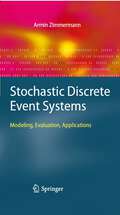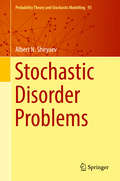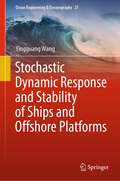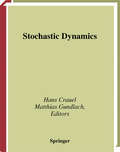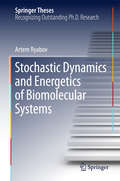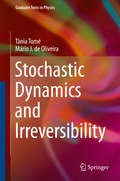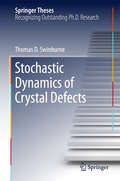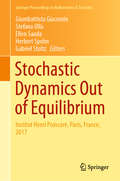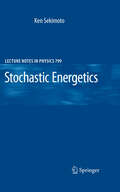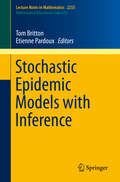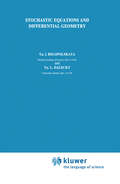- Table View
- List View
Stochastic Differential Inclusions and Applications (Springer Optimization and Its Applications #80)
by Michał KisielewiczThis book aims to further develop the theory of stochastic functional inclusions and their applications for describing the solutions of the initial and boundary value problems for partial differential inclusions. The self-contained volume is designed to introduce the reader in a systematic fashion, to new methods of the stochastic optimal control theory from the very beginning. The exposition contains detailed proofs and uses new and original methods to characterize the properties of stochastic functional inclusions that, up to the present time, have only been published recently by the author. The work is divided into seven chapters, with the first two acting as an introduction, containing selected material dealing with point- and set-valued stochastic processes, and the final two devoted to applications and optimal control problems. The book presents recent and pressing issues in stochastic processes, control, differential games, optimization and their application in finance, manufacturing, queueing networks, and climate control. Written by an award-winning author in the field of stochastic differential inclusions and their application to control theory, This book is intended for students and researchers in mathematics and applications; particularly those studying optimal control theory. It is also highly relevant for students of economics and engineering. The book can also be used as a reference on stochastic differential inclusions. Knowledge of select topics in analysis and probability theory are required.
Stochastic Differential Systems, Stochastic Control Theory and Applications: Proceedings of a Workshop, held at IMA, June 9-19, 1986 (The IMA Volumes in Mathematics and its Applications #10)
This IMA Volume in Mathematics and its Applications STOCHASTIC DIFFERENTIAL SYSTEMS, STOCHASTIC CONTROL THEORY AND APPLICATIONS is the proceedings of a workshop which was an integral part of the 1986-87 IMA program on STOCHASTIC DIFFERENTIAL EQUATIONS AND THEIR APPLICATIONS. We are grateful to the Scientific Committee: Daniel Stroock (Chairman) WendeIl Flerning Theodore Harris Pierre-Louis Lions Steven Orey George Papanicolaou for planning and implementing an exciting and stimulating year-long program. We es pecially thank WendeIl Fleming and Pierre-Louis Lions for organizing an interesting and productive workshop in an area in which mathematics is beginning to make significant contributions to real-world problems. George R. Seil Hans Weinberger PREFACE This volume is the Proceedings of a Workshop on Stochastic Differential Systems, Stochastic Control Theory, and Applications held at IMA June 9-19,1986. The Workshop Program Commit tee consisted of W.H. Fleming and P.-L. Lions (co-chairmen), J. Baras, B. Hajek, J.M. Harrison, and H. Sussmann. The Workshop emphasized topics in the following four areas. (1) Mathematical theory of stochastic differential systems, stochastic control and nonlinear filtering for Markov diffusion processes. Connections with partial differential equations. (2) Applications of stochastic differential system theory, in engineering and management sci ence. Adaptive control of Markov processes. Advanced computational methods in stochas tic control and nonlinear filtering. (3) Stochastic scheduling, queueing networks, and related topics. Flow control, multiarm bandit problems, applications to problems of computer networks and scheduling of complex manufacturing operations.
Stochastic Discounted Cash Flow: A Theory of the Valuation of Firms (Springer Texts in Business and Economics)
by Andreas Löffler Lutz KruschwitzThis open access book discusses firm valuation, which is of interest to economists, particularly those working in finance. Firm valuation comes down to the calculation of the discounted cash flow, often only referred to by its abbreviation, DCF. There are, however, different coexistent versions, which seem to compete against each other, such as entity approaches and equity approaches. Acronyms are often used, such as APV (adjusted present value) or WACC (weighted average cost of capital), two concepts classified as entity approaches.This book explains why there are several procedures and whether they lead to the same result. It also examines the economic differences between the methods and indicates the various purposes they serve. Further it describes the limits of the procedures and the situations they are best applied to. The problems this book addresses are relevant to theoreticians and practitioners alike.
Stochastic Discrete Event Systems: Modeling, Evaluation, Applications
by Armin ZimmermannStochastic discrete-event systems (SDES) capture the randomness in choices due to activity delays and the probabilities of decisions. This book delivers a comprehensive overview on modeling with a quantitative evaluation of SDES. It presents an abstract model class for SDES as a pivotal unifying result and details important model classes. The book also includes nontrivial examples to explain real-world applications of SDES.
Stochastic Disorder Problems (Probability Theory and Stochastic Modelling #93)
by Albert N. ShiryaevThis monograph focuses on those stochastic quickest detection tasks in disorder problems that arise in the dynamical analysis of statistical data. These include quickest detection of randomly appearing targets, of spontaneously arising effects, and of arbitrage (in financial mathematics). There is also currently great interest in quickest detection methods for randomly occurring intrusions in information systems and in the design of defense methods against cyber-attacks. The author shows that the majority of quickest detection problems can be reformulated as optimal stopping problems where the stopping time is the moment the occurrence of disorder is signaled. Thus, considerable attention is devoted to the general theory of optimal stopping rules, and to its concrete problem-solving methods.The exposition covers both the discrete time case, which is in principle relatively simple and allows step-by-step considerations, and the continuous-time case, which often requires more technical machinery such as martingales, supermartingales, and stochastic integrals. There is a focus on the well-developed apparatus of Brownian motion, which enables the exact solution of many problems. The last chapter presents applications to financial markets.Researchers and graduate students interested in probability, decision theory and statistical sequential analysis will find this book useful.
Stochastic Disorder Problems (Probability Theory and Stochastic Modelling #93)
by Albert N. ShiryaevThis monograph focuses on those stochastic quickest detection tasks in disorder problems that arise in the dynamical analysis of statistical data. These include quickest detection of randomly appearing targets, of spontaneously arising effects, and of arbitrage (in financial mathematics). There is also currently great interest in quickest detection methods for randomly occurring intrusions in information systems and in the design of defense methods against cyber-attacks. The author shows that the majority of quickest detection problems can be reformulated as optimal stopping problems where the stopping time is the moment the occurrence of disorder is signaled. Thus, considerable attention is devoted to the general theory of optimal stopping rules, and to its concrete problem-solving methods.The exposition covers both the discrete time case, which is in principle relatively simple and allows step-by-step considerations, and the continuous-time case, which often requires more technical machinery such as martingales, supermartingales, and stochastic integrals. There is a focus on the well-developed apparatus of Brownian motion, which enables the exact solution of many problems. The last chapter presents applications to financial markets.Researchers and graduate students interested in probability, decision theory and statistical sequential analysis will find this book useful.
Stochastic Distribution Control System Design: A Convex Optimization Approach (Advances in Industrial Control)
by Lei Guo Hong WangA recent development in SDC-related problems is the establishment of intelligent SDC models and the intensive use of LMI-based convex optimization methods. Within this theoretical framework, control parameter determination can be designed and stability and robustness of closed-loop systems can be analyzed. This book describes the new framework of SDC system design and provides a comprehensive description of the modelling of controller design tools and their real-time implementation. It starts with a review of current research on SDC and moves on to some basic techniques for modelling and controller design of SDC systems. This is followed by a description of controller design for fixed-control-structure SDC systems, PDF control for general input- and output-represented systems, filtering designs, and fault detection and diagnosis (FDD) for SDC systems. Many new LMI techniques being developed for SDC systems are shown to have independent theoretical significance for robust control and FDD problems.
Stochastic Dynamic Programming and the Control of Queueing Systems (Wiley Series in Probability and Statistics #504)
by Linn I. SennottA path-breaking account of Markov decision processes-theory and computation This book's clear presentation of theory, numerous chapter-end problems, and development of a unified method for the computation of optimal policies in both discrete and continuous time make it an excellent course text for graduate students and advanced undergraduates. Its comprehensive coverage of important recent advances in stochastic dynamic programming makes it a valuable working resource for operations research professionals, management scientists, engineers, and others. Stochastic Dynamic Programming and the Control of Queueing Systems presents the theory of optimization under the finite horizon, infinite horizon discounted, and average cost criteria. It then shows how optimal rules of operation (policies) for each criterion may be numerically determined. A great wealth of examples from the application area of the control of queueing systems is presented. Nine numerical programs for the computation of optimal policies are fully explicated. The Pascal source code for the programs is available for viewing and downloading on the Wiley Web site at www.wiley.com/products/subject/mathematics. The site contains a link to the author's own Web site and is also a place where readers may discuss developments on the programs or other aspects of the material. The source files are also available via ftp at ftp://ftp.wiley.com/public/sci_tech_med/stochastic Stochastic Dynamic Programming and the Control of Queueing Systems features: * Path-breaking advances in Markov decision process techniques, brought together for the first time in book form * A theorem/proof format (proofs may be omitted without loss of continuity) * Development of a unified method for the computation of optimal rules of system operation * Numerous examples drawn mainly from the control of queueing systems * Detailed discussions of nine numerical programs * Helpful chapter-end problems * Appendices with complete treatment of background material
Stochastic Dynamic Response and Stability of Ships and Offshore Platforms (Ocean Engineering & Oceanography #27)
by Yingguang WangThis textbook investigates in detail the methods for stochastic dynamic response and stability analyses of nonlinear systems (especially ships and ocean engineering systems), elucidating the advantages and disadvantages of each of the methods (the statistical linearization method, the perturbation method, the Monte Carlo Simulation method, the numerical path integration method, the global geometric method and the first passage theory). Studies on stochastic dynamic analysis of nonlinear systems have attracted engineers and scientists from various disciplines, such as aeronautical, civil, mechanical and ocean engineering. Pursuing a systematic approach, this book establishes a fundamental framework for this topic, while emphasizing the importance of accurate and efficient analysis as well as the significant influence of choosing a suitable method in the design and optimization of various nonlinear engineering systems (especially ships and ocean engineering systems).The textbook is intended for upper undergraduate and graduate students who are interested in advanced dynamic analysis technologies, researchers investigating nonlinear systems under stochastic dynamic excitations, and civil/mechanical/structural/ocean engineers working on designing and optimization of real-world nonlinear engineering systems. The basis of English translation of this book from its Chinese original manuscript was done with the help of artificial intelligence. A subsequent human revision of the content was done by the author.
Stochastic Dynamics
by Hans Crauel Matthias GundlachFocusing on the mathematical description of stochastic dynamics in discrete as well as in continuous time, this book investigates such dynamical phenomena as perturbations, bifurcations and chaos. It also introduces new ideas for the exploration of infinite dimensional systems, in particular stochastic partial differential equations. Example applications are presented from biology, chemistry and engineering, while describing numerical treatments of stochastic systems.
Stochastic Dynamics and Energetics of Biomolecular Systems (Springer Theses)
by Artem RyabovThis thesis both broadens and deepens our understanding of the Brownian world. It addresses new problems in diffusion theory that have recently attracted considerable attention, both from the side of nanotechnology and from the viewpoint of pure academic research. The author focusses on the difussion of interacting particles in restricted geometries and under externally controlled forces. These geometries serve, for example, to model ion transport through narrow channels in cell membranes or a Brownian particle diffusing in an optical trap, now a paradigm for both theory and experiment.The work is exceptional in obtaining explicit analytically formulated answers to such realistic, experimentally relevant questions. At the same time, with its detailed exposition of the problems and a complete set of references, it presents a clear and broadly accessible introduction to the domain. Many of the problem settings and the corresponding exact asymptotic laws are completely new in diffusion theory.
Stochastic Dynamics and Irreversibility (Graduate Texts in Physics)
by Tânia Tomé Mário J. de OliveiraThis textbook presents an exposition of stochastic dynamics and irreversibility. It comprises the principles of probability theory and the stochastic dynamics in continuous spaces, described by Langevin and Fokker-Planck equations, and in discrete spaces, described by Markov chains and master equations. Special concern is given to the study of irreversibility, both in systems that evolve to equilibrium and in nonequilibrium stationary states. Attention is also given to the study of models displaying phase transitions and critical phenomena both in thermodynamic equilibrium and out of equilibrium.These models include the linear Glauber model, the Glauber-Ising model, lattice models with absorbing states such as the contact process and those used in population dynamic and spreading of epidemic, probabilistic cellular automata, reaction-diffusion processes, random sequential adsorption and dynamic percolation. A stochastic approach to chemical reaction is also presented.The textbook is intended for students of physics and chemistry and for those interested in stochastic dynamics.It provides, by means of examples and problems, a comprehensive and detailed explanation of the theory and its applications.
Stochastic Dynamics for Systems Biology
by Christian Mazza Michel BenaimStochastic Dynamics for Systems Biology is one of the first books to provide a systematic study of the many stochastic models used in systems biology. The book shows how the mathematical models are used as technical tools for simulating biological processes and how the models lead to conceptual insights on the functioning of the cellular processing
Stochastic Dynamics in Computational Biology (Frontiers in Applied Dynamical Systems: Reviews and Tutorials #8)
by Stefanie Winkelmann Christof SchütteThe aim of this book is to provide a well-structured and coherent overview of existing mathematical modeling approaches for biochemical reaction systems, investigating relations between both the conventional models and several types of deterministic-stochastic hybrid model recombinations. Another main objective is to illustrate and compare diverse numerical simulation schemes and their computational effort. Unlike related works, this book presents a broad scope in its applications, from offering a detailed introduction to hybrid approaches for the case of multiple population scales to discussing the setting of time-scale separation resulting from widely varying firing rates of reaction channels. Additionally, it also addresses modeling approaches for non well-mixed reaction-diffusion dynamics, including deterministic and stochastic PDEs and spatiotemporal master equations. Finally, by translating and incorporating complex theory to a level accessible to non-mathematicians, this book effectively bridges the gap between mathematical research in computational biology and its practical use in biological, biochemical, and biomedical systems.
Stochastic Dynamics of Crystal Defects (Springer Theses)
by Thomas D SwinburneThis thesis is concerned with establishing a rigorous, modern theory of the stochastic and dissipative forces on crystal defects, which remain poorly understood despite their importance in any temperature dependent micro-structural process such as the ductile to brittle transition or irradiation damage.The author first uses novel molecular dynamics simulations to parameterise an efficient, stochastic and discrete dislocation model that allows access to experimental time and length scales. Simulated trajectories are in excellent agreement with experiment. The author also applies modern methods of multiscale analysis to extract novel bounds on the transport properties of these many body systems.Despite their successes in coarse graining, existing theories are found unable to explain stochastic defect dynamics. To resolve this, the author defines crystal defects through projection operators, without any recourse to elasticity. By rigorous dimensional reduction, explicit analytical forms are derived for the stochastic forces acting on crystal defects, allowing new quantitative insight into the role of thermal fluctuations in crystal plasticity.
Stochastic Dynamics of Structures
by Abdelkhalak El Hami Bouchaib RadiThis book is dedicated to the general study of the dynamics of mechanical structures with consideration of uncertainties. The goal is to get the appropriate forms of a part in minimizing a given criterion. In all fields of structural mechanics, the impact of good design of a room is very important to its strength, its life and its use in service. The development of the engineer's art requires considerable effort to constantly improve structural design techniques.
Stochastic Dynamics of Structures
by Abdelkhalak El Hami Bouchaib RadiThis book is dedicated to the general study of the dynamics of mechanical structures with consideration of uncertainties. The goal is to get the appropriate forms of a part in minimizing a given criterion. In all fields of structural mechanics, the impact of good design of a room is very important to its strength, its life and its use in service. The development of the engineer's art requires considerable effort to constantly improve structural design techniques.
Stochastic Dynamics Out of Equilibrium: Institut Henri Poincaré, Paris, France, 2017 (Springer Proceedings in Mathematics & Statistics #282)
by Giambattista Giacomin Stefano Olla Ellen Saada Herbert Spohn Gabriel StoltzStemming from the IHP trimester "Stochastic Dynamics Out of Equilibrium", this collection of contributions focuses on aspects of nonequilibrium dynamics and its ongoing developments.It is common practice in statistical mechanics to use models of large interacting assemblies governed by stochastic dynamics. In this context "equilibrium" is understood as stochastically (time) reversible dynamics with respect to a prescribed Gibbs measure. Nonequilibrium dynamics correspond on the other hand to irreversible evolutions, where fluxes appear in physical systems, and steady-state measures are unknown.The trimester, held at the Institut Henri Poincaré (IHP) in Paris from April to July 2017, comprised various events relating to three domains (i) transport in non-equilibrium statistical mechanics; (ii) the design of more efficient simulation methods; (iii) life sciences. It brought together physicists, mathematicians from many domains, computer scientists, as well as researchers working at the interface between biology, physics and mathematics.The present volume is indispensable reading for researchers and Ph.D. students working in such areas.
Stochastic Elasticity: A Nondeterministic Approach to the Nonlinear Field Theory (Interdisciplinary Applied Mathematics #55)
by L. Angela MihaiStochastic elasticity is a fast developing field that combines nonlinear elasticity and stochastic theories in order to significantly improve model predictions by accounting for uncertainties in the mechanical responses of materials. However, in contrast to the tremendous development of computational methods for large-scale problems, which have been proposed and implemented extensively in recent years, at the fundamental level, there is very little understanding of the uncertainties in the behaviour of elastic materials under large strains.Based on the idea that every large-scale problem starts as a small-scale data problem, this book combines fundamental aspects of finite (large-strain) elasticity and probability theories, which are prerequisites for the quantification of uncertainties in the elastic responses of soft materials. The problems treated in this book are drawn from the analytical continuum mechanics literature and incorporate random variables as basic concepts along with mechanical stresses and strains. Such problems are interesting in their own right but they are also meant to inspire further thinking about how stochastic extensions can be formulated before they can be applied to more complex physical systems.
Stochastic Energetics (Lecture Notes in Physics #799)
by Ken SekimotoStochastic Energetics by now commonly designates the emerging field that bridges the gap between stochastic dynamical processes and thermodynamics. Triggered by the vast improvements in spatio-temporal resolution in nanotechnology, stochastic energetics develops a framework for quantifying individual realizations of a stochastic process on the mesoscopic scale of thermal fluctuations. This is needed to answer such novel questions as: Can one cool a drop of water by agitating an immersed nano-particle? How does heat flow if a Brownian particle pulls a polymer chain? Can one measure the free-energy of a system through a single realization of the associated stochastic process? This book will take the reader gradually from the basics to the applications: Part I provides the necessary background from stochastic dynamics (Langevin, master equation), Part II introduces how stochastic energetics describes such basic notions as heat and work on the mesoscopic scale, Part III details several applications, such as control and detection processes, as well as free-energy transducers. It aims in particular at researchers and graduate students working in the fields of nanoscience and technology.
Stochastic Epidemic Models and Their Statistical Analysis (Lecture Notes in Statistics #151)
by Hakan Andersson Tom BrittonThe present lecture notes describe stochastic epidemic models and methods for their statistical analysis. Our aim is to present ideas for such models, and methods for their analysis; along the way we make practical use of several probabilistic and statistical techniques. This will be done without focusing on any specific disease, and instead rigorously analyzing rather simple models. The reader of these lecture notes could thus have a two-fold purpose in mind: to learn about epidemic models and their statistical analysis, and/or to learn and apply techniques in probability and statistics. The lecture notes require an early graduate level knowledge of probability and They introduce several techniques which might be new to students, but our statistics. intention is to present these keeping the technical level at a minlmum. Techniques that are explained and applied in the lecture notes are, for example: coupling, diffusion approximation, random graphs, likelihood theory for counting processes, martingales, the EM-algorithm and MCMC methods. The aim is to introduce and apply these techniques, thus hopefully motivating their further theoretical treatment. A few sections, mainly in Chapter 5, assume some knowledge of weak convergence; we hope that readers not familiar with this theory can understand the these parts at a heuristic level. The text is divided into two distinct but related parts: modelling and estimation.
Stochastic Epidemic Models with Inference (Lecture Notes in Mathematics #2255)
by Frank Ball Tom Britton Catherine Larédo Etienne Pardoux David Sirl Viet Chi TranFocussing on stochastic models for the spread of infectious diseases in a human population, this book is the outcome of a two-week ICPAM/CIMPA school on "Stochastic models of epidemics" which took place in Ziguinchor, Senegal, December 5–16, 2015. The text is divided into four parts, each based on one of the courses given at the school: homogeneous models (Tom Britton and Etienne Pardoux), two-level mixing models (David Sirl and Frank Ball), epidemics on graphs (Viet Chi Tran), and statistics for epidemic models (Catherine Larédo). The CIMPA school was aimed at PhD students and Post Docs in the mathematical sciences. Parts (or all) of this book can be used as the basis for traditional or individual reading courses on the topic. For this reason, examples and exercises (some with solutions) are provided throughout.
Stochastic Equations: Basic Concepts, Exact Results, and Asymptotic Approximations (Understanding Complex Systems)
by Valery I. KlyatskinThis monograph set presents a consistent and self-contained framework of stochastic dynamic systems with maximal possible completeness. Volume 1 presents the basic concepts, exact results, and asymptotic approximations of the theory of stochastic equations on the basis of the developed functional approach. This approach offers a possibility of both obtaining exact solutions to stochastic problems for a number of models of fluctuating parameters and constructing various asymptotic buildings. Ideas of statistical topography are used to discuss general issues of generating coherent structures from chaos with probability one, i.e., almost in every individual realization of random parameters. The general theory is illustrated with certain problems and applications of stochastic mathematical physics in various fields such as mechanics, hydrodynamics, magnetohydrodynamics, acoustics, optics, and radiophysics.
Stochastic Equations: Coherent Phenomena in Stochastic Dynamic Systems (Understanding Complex Systems)
by Valery I. KlyatskinIn some cases, certain coherent structures can exist in stochastic dynamic systems almost in every particular realization of random parameters describing these systems. Dynamic localization in one-dimensional dynamic systems, vortexgenesis (vortex production) in hydrodynamic flows, and phenomenon of clustering of various fields in random media (i.e., appearance of small regions with enhanced content of the field against the nearly vanishing background of this field in the remaining portion of space) are examples of such structure formation. The general methodology presented in Volume 1 is used in Volume 2 Coherent Phenomena in Stochastic Dynamic Systems to expound the theory of these phenomena in some specific fields of stochastic science, among which are hydrodynamics, magnetohydrodynamics, acoustics, optics, and radiophysics. The material of this volume includes particle and field clustering in the cases of scalar (density field) and vector (magnetic field) passive tracers in a random velocity field, dynamic localization of plane waves in layered random media, as well as monochromatic wave propagation and caustic structure formation in random media in terms of the scalar parabolic equation.



